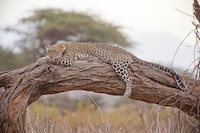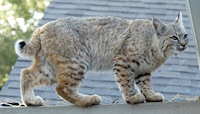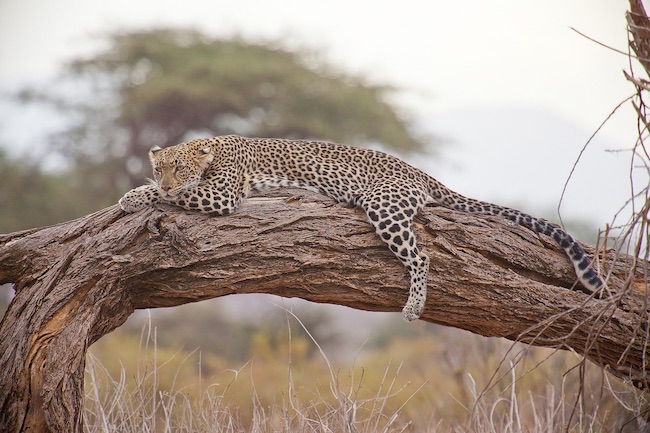







Bengal Tiger
 |
The Bengal tiger, also known as the Royal Bengal tiger, is the most populous and widely known subspecies of tiger in the world. It is native to the Indian subcontinent and can be found in India, Bangladesh, Bhutan, and Nepal. The Bengal tiger is an apex predator and is one of the most magnificent animals on the planet.
Appearance
The Bengal tiger is an iconic and striking animal. It is a large cat with a muscular build, and males can weigh up to 600 pounds while females can weigh up to 400 pounds. Its coat is orange with black stripes, which help it camouflage in the dense forests it inhabits. The white fur on its belly and chest is used to communicate with other tigers during mating season. The tiger's eyes are a bright yellow or green, and they have sharp teeth and claws, which they use to hunt prey.
Habitat
Bengal tigers can be found in a variety of habitats, including tropical and subtropical forests, grasslands, and wetlands. They prefer areas where water is plentiful, and they can often be found near rivers and lakes. Their range has been greatly reduced due to human activity, and their habitat is now fragmented into small patches of land. According to the World Animal Foundation, there are les than 5,600 Bengal tigers left in the wild.
Behavior
Bengal tigers are solitary animals, and they are most active at night. They are territorial and will mark their territory by spraying urine and rubbing against trees. They communicate through vocalizations such as growling, roaring, and chuffing. Bengal tigers are also known to be excellent swimmers and will often cross rivers to find food or a mate.
Diet
The Bengal tiger is a carnivore, and its diet consists mainly of deer, wild pigs, buffalo, and other large mammals. They are also known to hunt smaller animals such as birds, reptiles, and fish. Tigers are opportunistic hunters and will eat whatever prey is available in their territory.
Conservation
The Bengal tiger is listed as endangered on the IUCN Red List. The main threats to their survival are habitat loss, poaching, and human-wildlife conflict. Conservation efforts have been implemented in the countries where they are found, including anti-poaching measures, habitat restoration, and education programs. The Indian government has implemented the Project Tiger initiative, which has helped to increase the tiger population in India.
Siberian Tiger
 |
The Siberian tiger, also known as the Amur tiger, is the largest cat in the world and is found only in the remote forests of eastern Russia. With its magnificent size, stunning coat, and powerful presence, the Siberian tiger is one of the most awe-inspiring creatures on the planet. Here's a closer look at this magnificent animal.
Appearance
The Siberian tiger is the largest of all tiger subspecies, with males weighing up to 660 pounds and females up to 370 pounds. They have a distinctive orange coat with black stripes, and their fur is thicker and longer than that of other tiger subspecies, allowing them to survive in the cold climate of their habitat.
Habitat
Siberian tigers are found only in the remote forests of eastern Russia, in the Amur region near the border with China. They prefer habitats with plenty of cover and access to prey, including forests and taiga. The total range of the Siberian tiger has been reduced by habitat loss and poaching.
Behavior
Siberian tigers are solitary animals and are most active at dawn and dusk. They are skilled hunters and prey on a variety of animals, including elk, deer, wild boar, and even bears. They are also known for their strength and can take down prey much larger than themselves.
Diet
Siberian tigers are carnivores and feed primarily on large mammals. They require an average of 50-60 pounds of meat per day, and their diet consists of elk, deer, wild boar, and other large prey. They are also known to eat fish, when available.
Conservation
Siberian tigers are listed as an endangered species on the IUCN Red List, with only around 500 individuals remaining in the wild. Their populations are declining due to habitat loss, poaching, and human-wildlife conflict. Conservation efforts include habitat protection, anti-poaching measures, and education programs. The Siberian tiger's iconic status has also helped raise awareness about their plight, and there are now efforts to protect them in national parks and reserves throughout their range.
Conclusion
The Siberian tiger is a magnificent and powerful predator that faces numerous threats to its survival. It is important to continue conservation efforts to protect this iconic species and ensure its survival for future generations to enjoy. Through education and awareness, we can work together to save the Siberian tiger and other endangered species from extinction.
African Lion
 |
The African lion, also known as the king of the jungle, is a majestic and powerful animal that is native to the African continent. It is the second-largest living cat, after the tiger, and is the only social species of big cats, living in prides that can number up to 30 individuals. Here's a closer look at the African lion.
Appearance
African lions are the most sexually dimorphic of all the big cats, meaning that males and females have distinct physical differences. Males are larger and heavier than females, weighing up to 550 pounds and measuring up to 10 feet in length. Females, on the other hand, weigh up to 400 pounds and measure up to 9 feet in length. Both sexes have a short, tawny-colored coat with a long tail that ends in a black tuft of hair. Male lions also have a thick, shaggy mane of hair around their necks and heads, which serves as a sign of their strength and virility.
Habitat
African lions are found throughout sub-Saharan Africa, in savannas, grasslands, and even some forested areas. They prefer habitats that have a mix of vegetation and open spaces, allowing them to hunt and ambush their prey. Lions are also highly adaptable and can live in both arid and humid conditions.
Behavior
African lions are highly social animals and live in prides, which are groups made up of several females, their cubs, and one or two males. The males defend the pride's territory from other males and protect the females and cubs from threats. Females are the primary hunters and will work together to take down prey, while the males will usually eat first.
Diet
African lions are apex predators, meaning they are at the top of the food chain. They prey on a variety of animals, including wildebeest, zebras, gazelles, buffalo, and even small elephants. Lions are opportunistic hunters and will eat whatever is available in their territory.
Conservation
The African lion is listed as vulnerable on the IUCN Red List, with their populations declining across their range. The main threats to their survival are habitat loss, poaching, and human-wildlife conflict. Conservation efforts include habitat restoration, anti-poaching measures, and education programs. The lion's iconic status has also helped raise awareness about their plight, and there are now efforts to protect them in national parks and reserves across Africa.
Cheetah
 |
The cheetah is a fascinating animal that is known for its incredible speed and striking appearance. It is a large and slender big cat that is native to Africa and can be found in various habitats, from grasslands to savannas. Here's a closer look at the cheetah.
Appearance
The cheetah is the fastest land animal in the world, capable of reaching speeds of up to 70 miles per hour in short bursts covering up to 1,500 feet. It is a slender and agile cat that has a distinctive yellow coat with black spots. Its long legs and tail help it maintain balance and agility while running at high speeds. Cheetahs have a small head, a black tear mark below each eye, and a lean body, making them easily distinguishable from other big cats.
Habitat
Cheetahs can be found in a variety of habitats, from savannas to grasslands and even deserts. They prefer open spaces that allow them to run and hunt efficiently. However, cheetah populations are declining due to habitat loss, hunting, and human-wildlife conflict.
Behavior
Cheetahs are solitary animals and are most active during the day. They hunt by stalking their prey, usually antelopes or gazelles, and then chasing them down in a burst of speed. Cheetahs are also known for their unique hunting strategy, which involves tripping their prey with a swift blow to the legs. Unlike other big cats, cheetahs do not roar but instead communicate through various sounds, including chirps, purrs, and growls.
Diet
Cheetahs are carnivores and feed primarily on antelopes, gazelles, and other small to medium-sized mammals. They are opportunistic hunters and will eat whatever prey is available in their territory. Due to their speed and agility, cheetahs can catch their prey more easily than other predators.
Conservation
The cheetah is listed as vulnerable on the IUCN Red List, with an estimated population of fewer than 7,500 individuals remaining in the wild. The main threats to their survival are habitat loss, hunting, and human-wildlife conflict. Conservation efforts include habitat restoration, anti-poaching measures, and education programs. The cheetah's iconic status has also helped raise awareness about their plight, and there are now efforts to protect them in national parks and reserves across Africa.
Conservation Status
Jaguar
 |
The jaguar is a large and powerful wild cat that is native to the Americas, specifically Central and South America. It is the largest big cat in the Americas and is known for its beautiful coat and powerful build. Here's a closer look at the jaguar.
Appearance
Jaguars are large, muscular cats with a distinctive coat pattern of dark spots on a tawny background. Their coat helps them blend in with their surroundings in the dense forests and grasslands where they live. Jaguars have a powerful build, with stocky legs and a broad head. They are also known for their large and powerful jaws, which enable them to deliver a lethal bite to their prey.
Habitat
Jaguars are found in a variety of habitats, from dense rainforests to open grasslands and swamps. They prefer habitats that provide them with plenty of cover and access to water sources, which they need to survive. Jaguars are primarily found in Central and South America, from Mexico to Argentina.
Behavior
Jaguars are solitary animals and are most active at night. They are skilled hunters and prey on a variety of animals, including deer, peccaries, monkeys, and birds. Jaguars are also known for their swimming ability and will hunt fish and caimans in rivers and streams. They are also excellent climbers and will often rest or stalk prey from trees.
Diet
Jaguars are carnivores and feed primarily on medium to large-sized mammals, such as deer, peccaries, and tapirs. They are opportunistic hunters and will also eat smaller prey, such as birds and reptiles, when larger prey is scarce.
Conservation
Jaguars are classified as near threatened on the IUCN Red List, with their populations declining due to habitat loss, hunting, and human-wildlife conflict. Conservation efforts include habitat restoration, anti-poaching measures, and education programs. The jaguar's iconic status has also helped raise awareness about their plight, and there are now efforts to protect them in national parks and reserves across Central and South America.
Leopard
 |
The leopard, also known as Panthera pardus, is a beautiful and powerful big cat that is found in a variety of habitats throughout Africa and Asia. With its distinctive spotted coat and stealthy nature, the leopard is one of the most elusive and sought-after predators in the world. Here's a closer look at this magnificent animal.
Appearance
Leopards are easily recognized by their spotted coat, which varies in color from pale yellow to deep gold. The spots on their coat are black or dark brown and are shaped like rosettes. Leopards have a sleek, muscular build and are the smallest of the big cats, weighing between 70 and 200 pounds depending on their gender and the subspecies they belong to.
Habitat
Leopards are found throughout Africa and Asia in a variety of habitats, including savannas, grasslands, forests, and mountains. They are incredibly adaptable and are able to thrive in both hot and cold environments. Leopards are also known to live in close proximity to human settlements, including suburban areas and agricultural fields.
Behavior
Leopards are solitary animals and are primarily active at dawn and dusk. They are highly skilled hunters and prey on a variety of animals, including antelopes, deer, monkeys, and birds. Leopards are also able to climb trees and drag their prey up into the branches to avoid scavengers.
Diet
Leopards are carnivores and feed primarily on mammals, but they also eat birds, reptiles, and fish. Their diet depends on the availability of prey in their habitat, and they are known to be opportunistic hunters that will take advantage of any opportunity to catch a meal. Leopards are extremely powerful animals, and are known to drag prey as large as a deer up into trees.
Conservation
Leopards are listed as a vulnerable species on the IUCN Red List, with their populations declining due to habitat loss, poaching, and human-wildlife conflict. Conservation efforts include habitat protection, anti-poaching measures, and education programs. The leopard's iconic status has also helped raise awareness about their plight, and there are now efforts to protect them in national parks and reserves throughout their range.
Mountain Lion
 |
The mountain lion, also known as the cougar or puma, is a large wild cat that is native to North and South America. It is a solitary and elusive animal that is known for its power and agility. Here's a closer look at the mountain lion.
Appearance
Mountain lions are large, muscular cats with a tawny coat that helps them blend in with their surroundings. They have a long, slender body and powerful legs that enable them to jump up to 20 feet in a single leap. Mountain lions also have a long, thick tail that helps them maintain balance while running and climbing.
Habitat
Mountain lions are found in a variety of habitats, from dense forests to deserts and mountainous terrain. They prefer habitats that provide them with plenty of cover and access to prey, which they need to survive. Mountain lions are found throughout North and South America, from Canada to Argentina.
Behavior
Mountain lions are solitary animals and are most active at night. They are skilled hunters and prey on a variety of animals, including deer, elk, and small mammals such as rabbits and rodents. Mountain lions are also known for their stealth and agility, which they use to stalk and ambush their prey.
Diet
Mountain lions are carnivores and feed primarily on large mammals such as deer and elk. They are opportunistic hunters and will also eat smaller prey, such as rabbits and rodents, when larger prey is scarce.
Conservation
Mountain lions are classified as a species of least concern on the IUCN Red List, with their populations stable throughout much of their range. However, in some areas, their populations are declining due to habitat loss, hunting, and human-wildlife conflict. Conservation efforts include habitat restoration, anti-poaching measures, and education programs.
Bobcat
 |
The bobcat, also known as the lynx rufus, is a medium-sized wild cat that is native to North America. With its distinctive ear tufts and spotted coat, the bobcat is a fascinating and adaptable predator. Here's a closer look at this elusive animal.
Appearance
Bobcats have a distinctive appearance with their short, stubby tail, tufted ears, and spotted coat. They have a reddish-brown coat with black spots and stripes that help them blend in with their surroundings. Bobcats are about twice the size of an average house cat, with males weighing up to 30 pounds and females up to 20 pounds.
Habitat
Bobcats are found throughout North America, from southern Canada to northern Mexico. They prefer habitats with plenty of cover and access to prey, including forests, deserts, swamps, and scrublands. Bobcats are also known to adapt to human settlements, including suburban areas and agricultural fields. Occasionally, unsuspecting homeowners find a bobcat den under their deck.
Behavior
Bobcats are solitary animals and are most active at dawn and dusk. They are skilled hunters and prey on a variety of animals, including rabbits, rodents, birds, and deer. Bobcats are also known for their agility and can jump up to 12 feet in a single leap.
Diet
Bobcats are carnivores and feed primarily on small mammals such as rabbits and rodents. They are opportunistic hunters and will also eat birds, fish, and reptiles when prey is scarce.
Conservation
Bobcats are not currently listed as a threatened species, with their populations stable throughout much of their range. However, in some areas, their populations are declining due to habitat loss and hunting. Conservation efforts include habitat restoration, anti-poaching measures, and education programs.